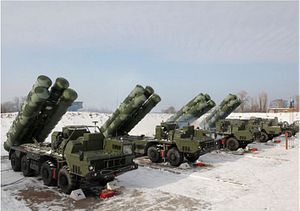The Russian military is set to continue its training of Chinese People’s Liberation Army (PLA) personnel this month with another batch of around 100 Chinese soldiers undergoing a training course on operating the Russian-made S-400 Triumf long-range interceptor-based air defense systems (NATO reporting name: SA-21 Growler), according to Russian media reports.
“About 100 military servicemen from the People’s Liberation Army of China will undergo instruction at a Russian training center in the operation and combat uses of the second regimental set of the S-400 system, to be provided to China in the second half of the year,” a Russian government source was quoted as saying by TASS news agency on February 5.
The People’s Liberation Army Rocket Force (PLARF) is in the process of standing up two S-400 regiments for an estimated $3 billion. China took delivery of its first S-400 regimental set in 2018. Delivery of the second regimental set was initially expected to be completed by the end of last year. Neither the Chinese nor Russian government have officially confirmed the completion of the delivery.
Notably, Russia claims that a cargo ship carrying an export variant of the S-400’s most advanced interceptor, the 40N6E, reportedly capable of intercepting targets at a distance of up to 400 kilometers, was damaged in a storm in the English Channel in early 2018. It is unclear, however, whether the 40N6E is operational yet and has entered serial production.
Both S-400 regiments are expected to receive the 40N6E in the near future. It appears that initial S-400 deliveries had been arranged to take place without the new long-range missile right from the start, with the two S-400 units to be retrofitted with the weapon system at a later stage once the 40N6E enters serial production.
The standard S-400 battery consists of four transporter erector launchers (TELs) with four large launch tubes or 16 smaller tubes (or a combination of the two) per TEL, in addition to long-range surveillance radar target acquisition and engagement (fire control) radar systems and a command post (vehicle). In the Russian military, two batteries make up an S-400 battalion (also known as an S-400 division), whereas an S-400 regiment consists of two battalions.
Each TEL can carry four long-range or up to 16 short- and medium-range missiles. An S-400 regiment also possesses additional surveillance and target acquisition radars, with the unit generally plugged in to larger long-range radar stations or airborne early warning systems. It is, however, unclear whether Russia has developed such a so-called Cooperative Engagement Capability (CEC). An entire regiment can be airlifted. As I explained previously:
In comparison to its predecessor, the S-300, the S-400 air defense system features an improved radar system and updated software; it can purportedly fire four new types of surface-to-air (SAM) missiles in addition to the S-300’s 48N6E, a vertical tube launched, solid fuel, single stage SAM with an estimated range of 150 kilometers (93 miles), and the improved 48N6E2 missile with a reported range of 195 kilometers (121 miles).
(…)
The S-400 is also armed with an improved variant of the 48N6E2 with an alleged range of 250 kilometers (160 miles). The air defense system can also fire two additional missiles, the 9M96E and 9M96E2 with respective ranges of 40 km (25 miles) and 120 km (75 miles). Improved S-300 air defense systems such as the S-300PMU-2 Favorite … can purportedly also fire the 9M96E and 9M96E2.
The PLARF purportedly conducted its second S-400 missile test launch in December 2018. “The target was reportedly intercepted at a distance of 250 kilometers (155 miles) suggesting that the PLARF has been supplied with upgraded variants of the 48N6E and 48N6E2, designated 48N6DM or 48N6E3,” I wrote in January of this year. “The 48N6 missile series is intended to engage intermediate-range ballistic missiles in their terminal phase.”
Notably, a recently published report by the Swedish Defense Research Agency (FOI) discusses in detail some of the purported operational limitations of the S-400 air defense system based on open source intelligence.































